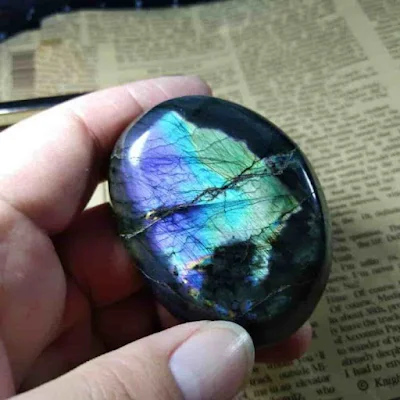Gemstones have been revered for centuries, cherished for their extraordinary beauty and enchanting allure. Among the vast array of gemstones, iridescent varieties stand out, captivating observers with their dazzling play of colors. This mesmerizing phenomenon, known as iridescence, is a result of the interaction of light with the internal or surface structures of the gemstones. In this exploration, we will delve into the world of iridescent gemstones, highlighting six of the most stunning and sought-after types that continue to capture the hearts of gem enthusiasts.
Opal: The Queen of Iridescence
The Virgin Rainbow opal from the South Australian Museum opal exhibition.
Credit: South Australian Museum.
Opal, often hailed as the "Queen of Gemstones," boasts a captivating play of colors that ranges from fiery reds and oranges to serene blues and greens. This iridescence is due to the presence of tiny silica spheres within the gemstone, causing light to diffract in a unique manner.
Australian opals, especially those from Lightning Ridge, are renowned globally for their exceptional quality. Ethiopian opals are also gaining prominence for their vibrant play of colors. Opals are frequently incorporated into jewelry, creating pieces that reflect both celestial elegance and the wearer's individuality.
Physical Properties of Opal
- Hardness: 5.5 - 6.5 on the Mohs scale
- Specific Gravity: 1.98 - 2.25
- Refractive Index: 1.37 - 1.47
- Cleavage: None
- Transparency: Opaque
Moonstone: A Celestial Elegance
Moonstone, with its ethereal glow reminiscent of moonlight, exhibits a phenomenon called adularescence. Alternating layers of albite and orthoclase within the feldspar mineral scatter light, creating a captivating play of blue or white hues.
Moonstone has a rich history in various cultures and is often associated with femininity, intuition, and spirituality. Its gentle shimmer makes it a popular choice for bohemian-inspired jewelry and designs that evoke timeless elegance.
Physical Properties of Moonstone
- Hardness: 6–6.5 on the Mohs scale
- Specific Gravity: 2.55–2.58
- Refractive Index: 1.518–1.526
- Cleavage: Perfect in one direction
- Transparency: Transparent to translucent
Labradorite: Nature’s Canvas of Color
Natural crystal Labradorite Purple Moonstone
Labradorite, resembling a painter’s palette, showcases vibrant flashes of blue, green, gold, and sometimes even purple—a phenomenon known as labradorescence. This captivating play of colors results from light interference caused by internal lamellar structures.
Hailing from the Labrador Peninsula in Canada, labradorite's unique charm has made it a favorite among jewelry designers and collectors alike. Its versatile colors make it an excellent choice for crafting statement pieces suitable for both day and night.
Physical Properties of Labradorite
- Hardness: 6–6.5 on the Mohs scale
- Specific Gravity: 2.68–2.72
- Refractive Index: 1.560–1.568
- Cleavage: Perfect in one direction
- Transparency: Transparent to translucent
Peacock Ore (Bornite): Nature’s Metallic Symphony
A 4 cm bornite aglomerate showing its tipical iridescence (a rainbow like luster)
Photo Copyright ©️ E. Zimbres and Tom Epaminondas Mineral Collector's
Peacock Ore, or Bornite, is a unique iridescent gemstone displaying a rainbow-like patina of metallic colors, including deep purples, blues, and bronzes. The surface oxidizes, creating a captivating symphony of iridescence.
While not as commonly used in jewelry, peacock ore is valued for its striking appearance and is sometimes featured in artisanal and unconventional pieces. Its name draws from the resemblance of its colors to the iridescent plumage of a peacock.
Physical Properties of Peacock Ore
- Hardness: 3 on the Mohs scale
- Specific Gravity: 4.9–5.3
- Cleavage: None
- Transparency: Opaque
Pearl: Ocean’s Luminescent Treasure
Various Pearls
Credit : MASAYUKI KATO
Pearls, associated with elegance and purity, achieve their iridescence through layers of nacre formed around an irritant within an oyster or mollusk. This process results in a captivating play of colors known as orient.
Cultured pearls, intentionally grown by pearl farmers, offer a diverse range of shapes, sizes, and colors. Akoya pearls are prized for classic tones, Tahitian pearls for striking blacks and grays, and freshwater pearls for their affordability and diversity.
Physical Properties of Pearls
- Hardness: 2.5–4.5 on the Mohs scale
- Specific Gravity: 2.60–2.78
- Refractive Index: 1.530–1.685
- Cleavage: None
- Transparency: Opaque
Sunstone: A Glimpse of Sunlight
This rough sunstone measures approximately 5 cm (2 inches) in length. Note how the green core follows the contours of the rough. The green core is characteristic of material from this mine.
Photo by Duncan Pay.
Sunstone, aptly named, captures the warmth and radiance of the sun through its sparkling aventurescence. Light reflects off mineral inclusions, such as hematite or goethite, creating golden hues reminiscent of a setting sun.
Oregon sunstone, with its warm tones ranging from soft peach to intense red, is highly regarded for its captivating play of colors. It is a popular choice for jewelry, infusing warmth and vibrancy into any ensemble.
Physical Properties of Sunstone
- Hardness: 6–6.5 on the Mohs scale
- Specific Gravity: 2.63–2.65
- Refractive Index: 1.525–1.548
- Cleavage: Perfect in two directions
- Transparency: Transparent to translucent
Iridescent gemstones offer a mesmerizing visual experience, each telling a unique story through their play of colors. From opals and moonstones to labradorite and pearls, these gems showcase the incredible beauty and diversity that nature has to offer, inviting us to appreciate the remarkable physical properties that make them truly extraordinary. Whether adorning jewelry or admired as specimen pieces, these six types of iridescent gemstones continue to remind us of the magical and captivating wonders found in the heart of the earth.
Tags:
Iridescent Gemstones







